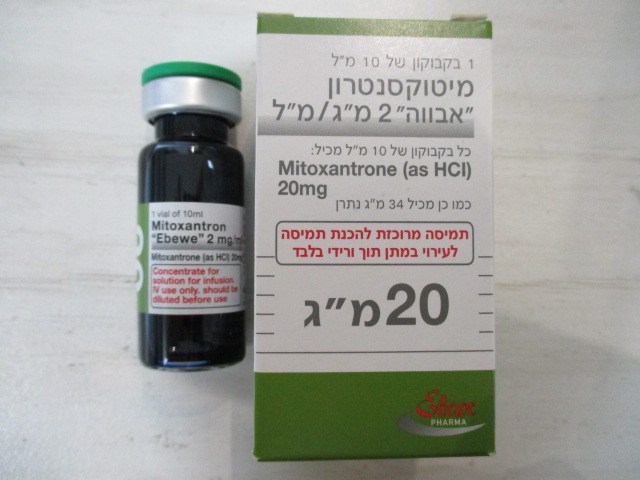Quest for the right Drug

מיטוקסנטרון "אבווה" 2 מ"ג/מ"ל MITOXANTRON "EBEWE" 2 MG/ML (MITOXANTRONE AS HYDROCHLORIDE)
תרופה במרשם
תרופה בסל
נרקוטיקה
ציטוטוקסיקה
צורת מתן:
תוך-ורידי : I.V
צורת מינון:
תרכיז להכנת תמיסה לאינפוזיה : CONCENTRATE FOR SOLUTION FOR INFUSION
עלון לרופא
מינוניםPosology התוויות
Indications תופעות לוואי
Adverse reactions התוויות נגד
Contraindications אינטראקציות
Interactions מינון יתר
Overdose הריון/הנקה
Pregnancy & Lactation אוכלוסיות מיוחדות
Special populations תכונות פרמקולוגיות
Pharmacological properties מידע רוקחי
Pharmaceutical particulars אזהרת שימוש
Special Warning עלון לרופא
Physicians Leaflet
Interactions : אינטראקציות
4.5 Interaction with other medicinal products and other forms of interaction Combining mitoxantrone with potentially cardiotoxic active substances (e.g. anthracyclines) increases the risk of cardiac toxicity. Topoisomerase II inhibitors, including mitoxantrone, when used concomitantly with other antineoplastic agents and/or radiotherapy, have been associated with the development of Acute Myeloid Leukaemia (AML) or Myelodysplastic Syndrome (MDS) (see section 4.8). Mitoxantrone causes myelosuppression as an extension of its pharmacological action. Myelosuppresion can be increased when it is used in combination chemotherapy with another myelosuppressive agent such as for treatment of breast cancer. The combination of mitoxantrone with other immunosuppressive agents may increase the risk of excessive immunodepression and lymphoproliferative syndrome. Immunisation with live virus vaccines (e.g. yellow fever vaccination) increases the risk of infection and other adverse reactions such as vaccinia gangrenosa and generalized vaccinia, in patients with reduced immunocompetence, such as during treatment with mitoxantrone. Therefore, live virus vaccines should not be administered during therapy. It is advised to use live virus vaccines with caution after stopping chemotherapy, and vaccinate not sooner than 3 months after the last dose of chemotherapy (see section 4.4). The combination of vitamin K antagonists and cytotoxic agents may result in an increased risk of bleeding. In patients receiving oral anticoagulant therapy, the prothrombin time ratio or INR should be closely monitored with the addition and withdrawal of treatment with mitoxantrone and should be reassessed more frequently during concurrent therapy. Adjustments of the anticoagulant dose may be necessary in order to maintain the desired level of anticoagulation. Mitoxantrone has been demonstrated to be a substrate for the BCRP transporter protein in vitro. Inhibitors of the BCRP transporter (e.g. eltrombopag, gefitinib) could result in an increased bioavailability. In a pharmacokinetic study in children with de novo acute myeloid leukaemia, ciclosporin co-medication resulted in a 42% decreased clearance of mitoxantrone. Inducers of the BCRP transporter could potentially decrease mitoxantrone exposure. Mitoxantrone and its metabolites are excreted in bile and urine, but it is not known whether the metabolic or excretory pathways are saturable, may be inhibited or induced, or if mitoxantrone and its metabolites undergo enterohepatic circulation (see section 5.2).

שימוש לפי פנקס קופ''ח כללית 1994
לא צוין
תאריך הכללה מקורי בסל
01/01/1995
הגבלות
תרופה מוגבלת לשימוש בבתי חולים או אשפוז יום
מידע נוסף
